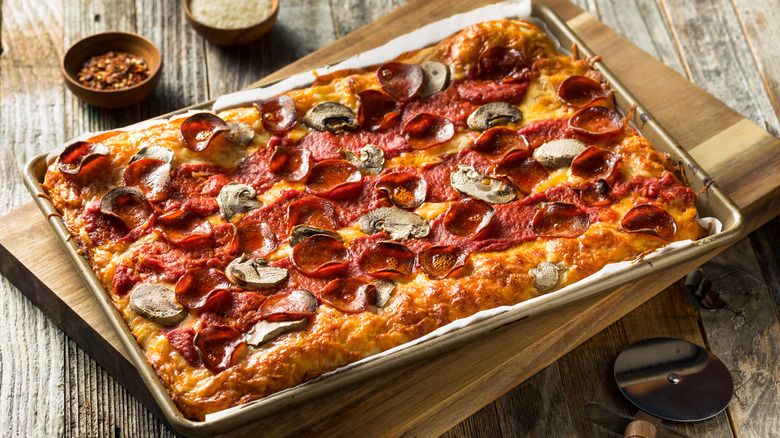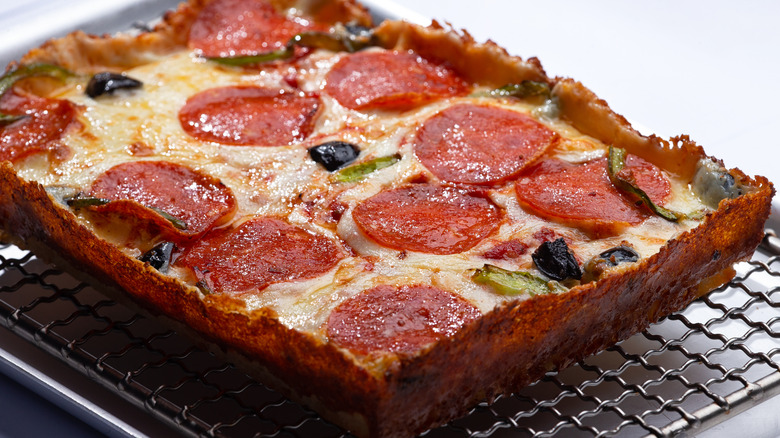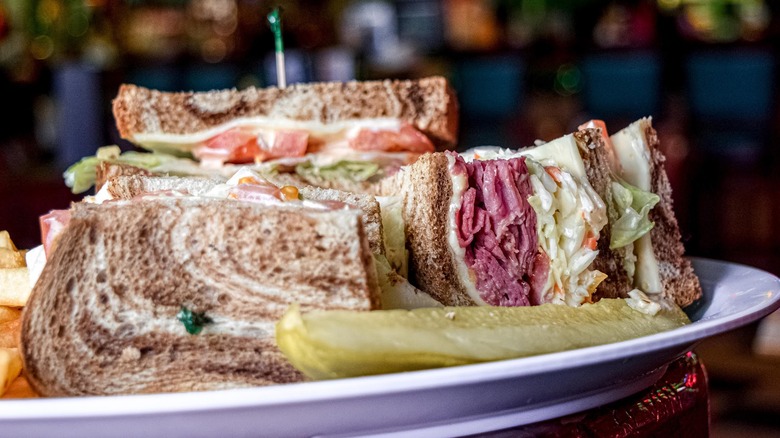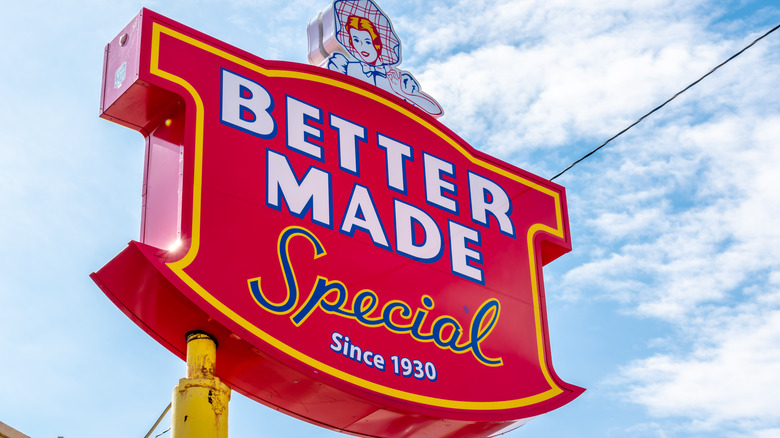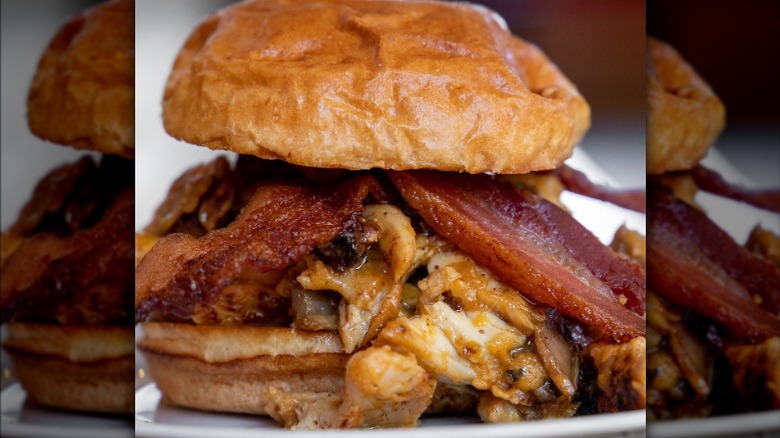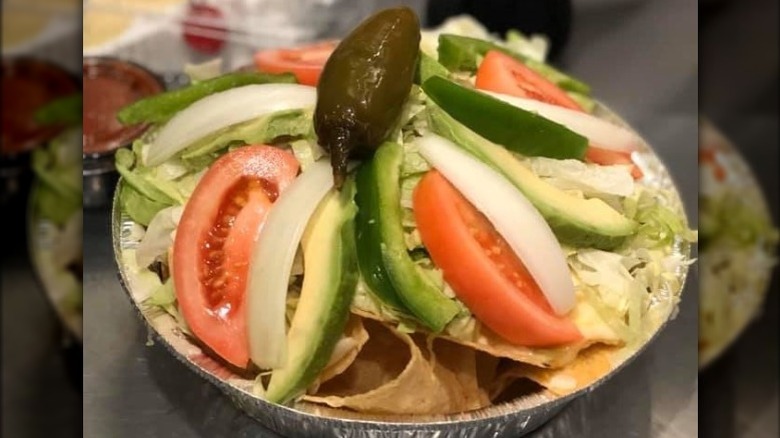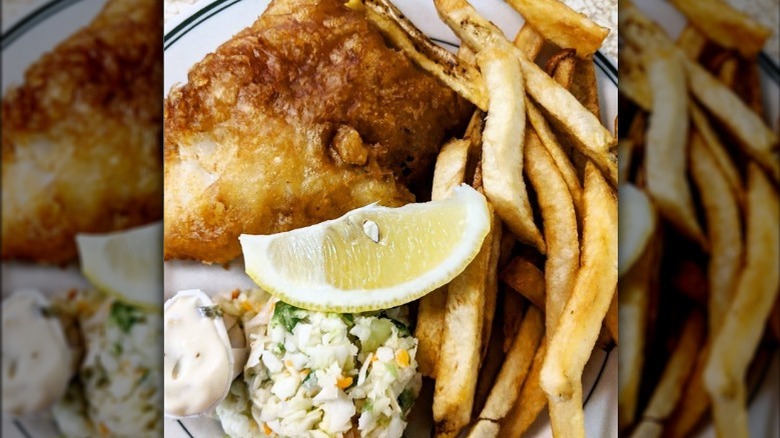12 Classic Detroit Foods You Need To Try Before You Die
Detroit is a city with a long history. Founded by the French in 1701, then captured by the British in 1760, Detroit finally became part of the United States in 1783. The first German immigrant, Michael Yax, arrived in 1751, and the first Black man to own land, Jacob Young, settled there in 1793. And before all of that, there were several Native American tribes living throughout the region, like the Potawatomi, Ottawa, and Ojibwa, many of whom remain today. So, you can see that Detroit has been a place of diversity from the very beginning (via Detroit Historical Society). Today, you will find many pockets of long established different cultures, such as Polish, Greek, Italian, and especially African American (nearly 78% of the city is Black according to the U.S. Census Bureau). Per local radio station WDET, Detroit is also home to one of the largest Arab-American populations in the U.S.
Thanks to all of these diverse cultures, each with truly rich histories, when you visit Detroit, you can expect some amazing cuisine! Detroit's immigrant communities have been interacting for centuries, and it shows in some of the most iconic Detroit foods that are absolute must-tries for any foodie. If you love good food, you have to add Detroit to your bucket list.
Coney dogs
One of Detroit's most iconic food is the Coney Island hot dog, more often called a Coney dog, or simply a Coney — and it's not to be confused with the popular New York amusement park, or the Nathan's hot dog sold there. As Smithsonian Magazine explains, in Michigan, a Coney Island is a specific type of diner that serves classic Greek and American fare, including Coney dogs. Per the Detroit Historical Society, a Coney dog is a beef hot dog topped with beanless meat chili, diced white onions, and yellow mustard. The Coney dog was brought to Michigan in the early 20th century by Greek immigrants who passed through New York City. While there are hundreds of Coney Islands in Michigan, two are quintessentially Detroit — and the rivalry is real. As laid out in The Metropolitan, you are either for Lafayette Coney Island or American Coney Island.
Constantine Keros opened American Coney Island in 1917. Now over 100 years old, it remains one of Detroit's oldest family-owned and operated businesses. American's recipe for Coneys is as listed above. Keros brought his brother William into the business, but their partnership was not a happy one. William opened his own Coney Island right next door to American, naming it Lafayette, presumably after the street where it is located. Unlike American, Lafayette is no longer owned by the Keros family. Lafayette's Coney recipe is different from American's as well. It uses pork hot dogs rather than beef, and Spanish onions in place of white onions. Each restaurant has its own recipe for chili sauce, too. You may have to try both to get the full Detroit experience, and then you can decide for yourself which you prefer.
Detroit-style pizza
Many people may not be aware that Detroit has its own style of pizza. In its most basic form, a Detroit-style pizza is rectangular in shape, layers pepperoni directly on top of the dough, has crumbled Wisconsin brick cheese spread all the way to the edge of the pan (which causes it to caramelize during baking), and sauce ladled on top. Other toppings are also now commonly added, too.
According to Michigan Radio, Detroit-style pizza was designed by August "Gus" Guerra, a bar owner in Detroit. Just after World War II, veterans came into Guerra's bar and talked about the pizzas they had eaten while stationed in Italy. This inspired Guerra to make a Sicilian-style pizza to satisfy his patrons' cravings. But this is where he ran into some trouble. Guerra couldn't find the right pan to make a good pizza. For this, he turned to another staple of Detroit: the automotive industry. He learned from his customers of a rectangular pan that was used as a drip pan or to hold loose nuts and bolts at the local auto shops. While there may be many imitators, this is one of the keys to what makes Detroit-style pizza truly Detroit-style.
And if you want the original, you have to head to Buddy's, originally Buddy's Rendezvous, which has grown from Guerra's bar into a small pizza chain in Metro Detroit. CEO of Buddy's, Burton Heiss, told PMQ Pizza Media, "Detroit-style pizza is more than a trend—it's a tradition." And it's one that cannot be missed!
Paczki
While New Orleans parties for Mardi Gras in preparation for the beginning of Lent, Detroit celebrates Paczki Day. Eater explains that paczki (pronounced "POHNCH-key") are a type of Polish jelly donut that, outside of Poland, are popular in cities with a high concentration of Polish immigrants and families — such as Chicago and Detroit. In Detroit, the place many head to on Paczki Day is Hamtramck, a small city within the larger city of Detroit, known by the slogan of "The World in Two Square Miles." Originally settled by Germans, Hamtramck became the center for Polish immigrants throughout the 20th century. It is this community that we can thank for this delicious addition to the Detroit foodscape.
While prune and rosehip are traditional paczki fillings, Click On Detroit points out that these are by no means the only choices. Buttercream frosting, cannoli cream, raspberry jam, and more have all been piped into a puffy paczki. Paczki can also be made vegan and gluten free, too. While it might be fun to get up early, head to the nearest Polish bakery, and wait in a line that circles the block à la Black Friday, you will save yourself a lot of grief by ordering ahead of time. And when all else fails, boxes of paczki are also available at local grocery stores, such as Kroger.
Corned beef egg rolls
Bread Basket Deli owner Alex Winkler told Visit Detroit that Detroit is the second-largest consumer of corned beef in the U.S. (And no, the first isn't New York — it's Cleveland.) Historian Jamon Jordan explained that the reason why a traditionally Jewish food is so popular in a majority Black city is because, since the 1840s, African Americans lived in the same neighborhoods occupied by Jewish people. "Jewish delis and restaurants were among the major establishments in these neighborhoods, placing African Americans in contact with Jewish dishes. Corned beef being the top of the menu in most of these places," he elaborated.
African Americans aren't the only community that had contact with Jewish delis. Detroit Metro Times reported that after Kim White met her husband and immigrated to the U.S. from Vietnam in 1974, she got a job at a Jewish deli. Combining her deli experience with her personal experience and heritage, she created the corned beef egg roll four years later. While other delis in the area have replicated it, including Bread Basket Deli, the original is found at White's own Asian Corned Beef. Said White, "A lot of my customers say, 'Yeah, Kim, they sell your egg rolls here, but they can't touch you.'" She continued, "Half the city of Detroit knows me and my food." Trust us when we say that you will want to know her food, too.
Bumpy Cake
Detroit's favorite confectionery Sanders was founded in 1875 by Fred Sanders Schmidt. According to the Detroit Historical Society, he dropped the Schmidt to distinguish himself from his father, who owned a bakery. Sanders moved to Detroit from Chicago after his candy shop was destroyed in the Great Chicago Fire in 1871, which, oddly enough, turned out to be a blessing in disguise. His new store in Detroit included a soda fountain, where he introduced Detroit to the ice cream soda. He also sold baked goods. One of Sanders' most famous baked goods is their trademarked Bumpy Cake. It may have a funny name, but it is pure decadence. Sanders created it in 1912 in honor of his father who loved devil's food cake, which is the base of the Bumpy. Ridges, or "bumps," of buttercream top the cake, and the entire thing is then covered in chocolate ganache.
Sanders originally named the cake Devil's Food Buttercream Cake, but it was changed after customers frequently referred to it as "the cake with the bumps." The bumps actually came about because Sanders was running low on the buttercream frosting when he was testing out different recipes. People liked them, so they stayed. Today you can get Bumpy Cake in more than devil's food cake. And if you can't make the trip to Detroit, you can order a Bumpy Cake from Sanders and have it shipped to you, wherever you are in the world.
Boston Cooler
The type of ginger ale you drink might earn you a sidelong glance in Michigan, unless that ginger ale is Vernors. Originally a Detroit company, the Detroit Free Press reported that the beloved beverage, which turned 150-years-old in 2016, is no longer made in the city. However, this hasn't stopped Michiganders, especially Detroiters, from turning to a glass of Vernors for various occasions and remedies.
So, what does Vernors have to do with Boston? Nothing really. According to Atlas Obscura, the alcoholic cocktail Boston Cooler originated in Massachusetts in the late 19th century. It was made by combining rum, lime, and soda water. Over the years, the alcoholic drink became non-alcoholic — and entirely different — and was served at soda fountains across the U.S. In Detroit, the Boston Cooler was first a glass of Vernors with a scoop of vanilla ice cream, then later a blending of the two — like a milkshake without the milk. You can order a Boston Cooler at several ice cream parlors throughout the city. Some bars even offer an alcoholic version. Is there a better way to cool off during the hot and muggy Michigan summer day? We don't think so.
Dinty Moore sandwich
Despite its name, the Dinty Moore sandwich does not involve the famous beef stew. But there is beef, and lots of it. We've already established how incredibly popular corned beef is in Detroit. Eat Your World explains that a Dinty Moore sandwich is Detroit parlance for an extra large corned beef sandwich with Swiss cheese, coleslaw, Russian dressing, and occasionally lettuce and tomato. There are slight variations between delis, however.
Grobbel's Gourmet, which has served Detroit since 1883, makes their Dinty Moores with corned beef, coleslaw, Swiss cheese, and Russian dressing on rye, then grilled and served warm. The Bread Basket's version (per Food Network) contains a triple serving of corned beef, Russian dressing, and tomato. Zingerman's Delicatessen, located in Ann Arbor, Michigan, also makes a Dinty Moore that contains corned beef, lettuce, tomato, and house-made Russian dressing layered between two slices of Jewish rye bread. No matter how you slice it, the Dinty Moore is a popular sandwich. As one enthusiastic Twitter user put it, "Dinty Moore sandwich tastes so good, make you wanna slap your mama!"
Better Made potato chips
According to the Detroit Historical Society, the Better Made Snack Food Company was founded in 1930 by two Sicilian immigrants, Cross Moceri and Peter Cipriano. At first, the company was named for its founders, Cross & Peters Company, but it was changed to Better Made in 1934 in direct opposition to the now long gone Best Maid potato chip company. Are Better Made potato chips really made better than the competition? Detroit residents think so.
Better Made was born in Detroit and continues to thrive there. Sal Cipriano, son of co-founder Peter Cipriano, explained in a video on USA Today that the company has always used Michigan-grown potatoes to make its chips and employs local Detroit citizens. "We're the best thing to ever happen here," he said, "Other than Henry Ford and the automobile." Per The Detroit News, Better Made's current CEO (as of 2021) is Catherine Gusmano, daughter of Peter Cipriano. She took over from her brother Sal after his death.
Better Made was able to expand its reach after Michigan-based superstore Meijer began carrying Better Made chips in its many locations across the Midwest. And the potato chip company is also not without its unofficial personal ambassadors. AEW professional wrestler Danhausen, who was born in Detroit, has become known for his love of Better Made chips, as seen on his YouTube and Twitter. The potato chips were central to a plot line in which Danhausen befriended fellow wrestler Hook, as documented on YouTube. Fans across the U.S. took notice.
Slows Bar BQ Yardbird sandwich
Better Made chips aren't the only Detroit brand that made national TV. In 2012, MLive reported that Slows Bar BQ's Yardbird sandwich was featured on the Travel Channel's series "Adam Richman's Best Sandwich in America." Richman even called Slows Bar BQ "one of my favorite restaurants in all of America" (per Travel Channel). Richman interviewed Slows' chef Brian Perrone, a native of Detroit, while Perrone showed him how to make the famous Yardbird. Perrone said that the secret to Slows' success is that, while at first the restaurant tried to bring in barbecue traditions from other regions, it finally settled on developing its own style.
As for the sandwich, Richman explained it begins with "farm-fresh, hickory-smoked Amish chicken," which was so tender, they just ripped the meat apart. The chicken is then sautéed with mushrooms, Slows' house-made mustard barbecue sauce, and a little bit of water to keep the sauce from sticking to the pan. Shredded cheddar is then added to the pan and stirred together with the chicken and sauce. This mixture was scooped onto a toasted poppy seed bun and topped with a few strips of applewood smoked bacon. "I really like the smoky taste that the chicken has," said one Yardbird fan on Richman's show. "Anything with bacon on it is a huge plus in my book, and the cheddar cheese kind of melts through it all and ties it all together. So it's an awesome sandwich." How could anyone resist?
Botana
Maybe you've heard of Detroit's Greektown, one of the city's most hopping entertainment districts where you can get a taste of authentic Greek cuisine. But did you know that Detroit also has Mexicantown? For anyone who loves Mexican food, Mexicantown is a must-stop. And while you're there, be sure to try the uniquely Detroit botanas.
Thrillist points out that while "botana" literally translates from Spanish as snack or appetizer, and, in Detroit, this word takes on a very specific meaning. Fans of nachos will likely also fall for botanas. Both dishes start with a bed of tortilla chips. Then comes a layer of a blend of refried beans and chorizo, diced onions, slices of avocado, green peppers, tomatoes, jalapeño, and a generous topping of melted Muenster cheese. Some restaurants also offer green olives, one of Michigan's favorite toppings (see: the olive burger). A review on Tripadvisor called botana "the ultimate comfort food."
As Detour Detroit reveals, Detroit-style botana was invented in 1975 by Mexican-American Armando Galan, a transplant from Texas, for his restaurant namesake Armando's. Galan passed away in March of 2020, but his legacy lives on. His children have opened their own restaurants across Metro Detroit, and of course include their father's famous botana on their menus.
Scotty Simpson's fish and chips
Local news program Click on Detroit interviewed the owner of Detroit favorite Scotty Simpson's Fish & Chips, Harold "Harry" Barber, in 2018, just in time for Lent, when Catholics opt for a fish dinner (instead of meat) on Fridays. Barber explained that the name comes from the original owner, who was a butcher from Scotland known as Scotty. Barber also boasted, "We have the best fish and chips in the world." The interior of Scotty Simpson's has a retro diner feel, complete with an old jukebox. While you can order things like fried shrimp and frog legs, the restaurant is most famous for its fish and chips. Pieces of cod are fried in their signature batter, then served on a plate piled with golden French fries, a scoop of coleslaw, and tartar sauce.
One review on Tripadvisor said, "My new favorite fish place when in the Detroit area. Fish was fresh and cooked to perfection." Another reviewer said about their visit, "The [place] was packed. The service was friendly. They made you feel like family." You don't have to wait for Lent to enjoy a bite at Scotty Simpson's. There's a reason it's been going strong since 1950 — it just might be the best in the world, after all.
The original Superman ice cream
When Prohibition outlawed the sale of alcohol in the U.S., the Stroh Brewery Company in Detroit had to pivot its business in order to avoid shutting down. According to The 'Gander, one of Stroh's new products was ice cream, which included the brand new multi-flavored Superman. Superman — which is meant to evoke the superhero's signature colors of red, yellow, and blue, has been replicated by other ice cream companies since then. Atlas Obscura lists the also Michigan-based Hudsonville's SuperScoop and Meijer Purple Cow's Scooperman as examples. But Stroh's is considered the creator of the tri-colored treat, and its choice of three flavors are the original.
That's right, while different ice creameries all make their own red, yellow, and blue-colored ice creams, the flavors are not necessarily the same. In Stroh's blend, the red is Red Pop flavored (Red Pop being a strawberry-flavored creation of Detroit's Faygo Beverages). The yellow is lemon ice cream, and the blue is another popular Michigan flavor called Blue Moon. According to Awesome Mitten, the exact flavor of Blue Moon is a tightly held secret, though people have likened it to marshmallow, almond, and fruity cereals. Both Hudsonville and Meijer use cherry ice cream for their red and vanilla for their yellow, while other creameries use cherry and lemon. The blue usually remains Blue Moon. So, if you want the original, reach for Stroh's.
